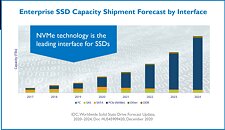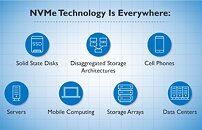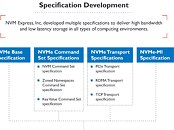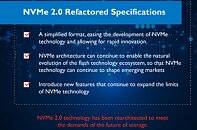Thursday, June 3rd 2021
NVM Express Announces NVMe 2.0 Specification
NVM Express, Inc. today announced the release of the NVM Express (NVMe ) 2.0 family of specifications. The restructured NVMe 2.0 specifications allow for faster and simpler development of NVMe solutions to support the increasingly diverse NVMe device environment, now including Hard Disk Drives (HDDs). The extensibility of the specifications encourages the development of independent command sets like Zoned Namespaces (ZNS) and Key Value (KV) while enabling support for the various underlying transport protocols common to NVMe and NVMe over Fabrics (NVMe-oF ) technologies.
"NVMe technology is the leading interface for SSDs, with overall worldwide enterprise SSD capacity expected to grow at a 43% compound annual growth rate into 2024," said Jeff Janukowicz, research vice president, IDC. "NVMe architecture is designed for future SSD development and form factors, as we enter a new era in hyperscale and enterprise computing that drives digital transformation.""We have rearchitected the NVMe 2.0 library of specifications to meet the evolving demands of the future of storage," said Amber Huffman, NVM Express president. "NVMe technology has unified client, cloud and enterprise storage around a common command set and architecture. Our Technical Work Group has worked diligently to optimize the features of the NVMe 2.0 specifications for diverse market segments, allowing for emerging use cases and opening new NVMe device types."
NVMe 2.0 Specifications: New Layout Will Propel Industry Development and Momentum
The NVMe 2.0 library of specifications consist of multiple documents, including the NVMe Base specification, Command Set specifications (NVM Command Set specification, ZNS Command Set specification, KV Command Set specification), Transport specifications (PCIe Transport specification, Fibre Channel Transport specification, RDMA Transport specification and TCP Transport specification) and the NVMe Management Interface specification.
The new specifications will facilitate the emerging NVMe device ecosystem, including enterprise and client solid state drives (SSDs), removable cards, compute accelerators and HDDs.
Key NVMe 2.0 Features:
"NVMe technology is the leading interface for SSDs, with overall worldwide enterprise SSD capacity expected to grow at a 43% compound annual growth rate into 2024," said Jeff Janukowicz, research vice president, IDC. "NVMe architecture is designed for future SSD development and form factors, as we enter a new era in hyperscale and enterprise computing that drives digital transformation.""We have rearchitected the NVMe 2.0 library of specifications to meet the evolving demands of the future of storage," said Amber Huffman, NVM Express president. "NVMe technology has unified client, cloud and enterprise storage around a common command set and architecture. Our Technical Work Group has worked diligently to optimize the features of the NVMe 2.0 specifications for diverse market segments, allowing for emerging use cases and opening new NVMe device types."
NVMe 2.0 Specifications: New Layout Will Propel Industry Development and Momentum
The NVMe 2.0 library of specifications consist of multiple documents, including the NVMe Base specification, Command Set specifications (NVM Command Set specification, ZNS Command Set specification, KV Command Set specification), Transport specifications (PCIe Transport specification, Fibre Channel Transport specification, RDMA Transport specification and TCP Transport specification) and the NVMe Management Interface specification.
The new specifications will facilitate the emerging NVMe device ecosystem, including enterprise and client solid state drives (SSDs), removable cards, compute accelerators and HDDs.
Key NVMe 2.0 Features:
- The ZNS specification provides a zoned storage device interface that allows the SSD and host to collaborate on data placement. ZNS permits data to be aligned to the physical media of the SSD, improving overall device performance and cost while increasing the media capacity that can be made available to the host.
- The KV Command Set provides access to data on an NVMe SSD controller using a key rather than a block address. KV allows applications to directly communicate with the drive using key-value pairs, avoiding the overhead of translation tables between keys and logical blocks.
- Namespace Types provides a mechanism to allow an NVMe SSD controller to support the different command sets that are defined as part of the NVMe 2.0 release as well as a path for future command sets.
- NVMe Endurance Group Management enables media to be configured into Endurance Groups, exposing granularity of access to the SSD and improving control.
- Rotational Media support enables support for HDD on NVMe technology with updates to features, management capabilities and other enhancements required for HDD support.
- Multiple Controller Firmware Update defines behavior for firmware updates on complex systems with multiple controllers.
- Shutdown enhancements enable showdown control from enclosure management for simplified management of many drives at once.
- Simple Copy Command copies data from one namespace in the drive, offloading the copy operations from multiple source LBAs to a single destination LBA.
- 32/64 bit CRC expands the protection information and data protection to 32 and 64 bit allowing for new types of meta data use cases.
- Command Group Control prevents unintended changes after a system is provisioned and protects the system from unintentional or malicious changes.
- NVMe 2.0 specifications maintain backwards compatibility with previous NVMe generations.




22 Comments on NVM Express Announces NVMe 2.0 Specification
Then I gave up reading this post.
:ohwell:
There's so much I don't know, every day is a learning experience.
However i do believe that the tech by now for consumers is getting outdated.
The reliability of good SSD's on it's own just beat the HDD's completely.
I doubt most manufacturers will bother. Perhaps Samsung and some others who make top 4.0 drives.
Indeed, the new features are of most interest to the server world, and this is Anandtech's conclusion, too. We'll see what comes of zoned storage, which may be useful on the client side, some day, too.How often do peripherals, of any kind, get many significant new features with firmware updates? There are third party projects like DD-WRT for routers and CHDK for Canon cameras, but what about official firmware?Not drives that exist today but those that come to the market in the near future, like next 6-12 months, before manufacturers implement the new features. Samsung and others would be wise to make them upgradeable, and advertise them as such of course.
Or older AM4 motherboards gaining new CPU support and even PCIe 4.0 on B450 althought this was shut down by AMD real quick. There are also some official (beta obviously) AsRock BIOS versions out there that support Ryzen 5000 on select X370 and B350 boards.
Or GPU's gaining ReBAR support via vBIOS update for example. Or older DX11 cards gaining DX12 support (tho this is a bit murky due to "levels" in DX support). Im sure there are other examples of this.
Either way, I think it's time that SATA gets retired. I have a socket 478 Celeron machine in the attic with SATA 1.5G which goes to show how old SATA is.
NVMe over SATA? Nah, we're not talking about stuff for consumers here.
I just fear it'll result in prebuilts and laptops with NVME plastered all over them, and turn out to be mech only.
I wish the next SATA replacement will have at least few watts of power, like <15-20W per drive. And seeing that the new move by the industry is for 12V, this can be done more easily for 2.5" drives as they have plenty of space for a small voltage regulator 12V to 5V & 3.3V. Allowing most consumer grade drives to work with a single cable. And an optional power cable for more powerful drives.
It should also have some sort of PCIe bifurcation, basically a storage controller will looks like a regular PCIe switch. You can't waste x4 lanes on a regular SATA drive even for cheap SATA SSD, a single PCIe 3.0 x1 lane is enough for this. I know next generation of Mechanical HDD's is going to be faster (like the new Seagate Multi-Actuators which reaches 500-600MB/s) which means PCIe 3.0 x1 will be saturated for it, but it won't be saturated except in sustained read performance.
A single cable from the motherboard can go to the drive cage in the case, driving 4 drives in the same time (or even more if that single cable was PCIe 4.0 or 5.0 x4 lanes). Either by splitting the cable, or better, having a drive backbone built in in the case (like standard NAS or external drive bays) allowing for neater looks, better air flow & better data & power management. This will be the perfect use case for storage drives (either SSD or HDD based ones).